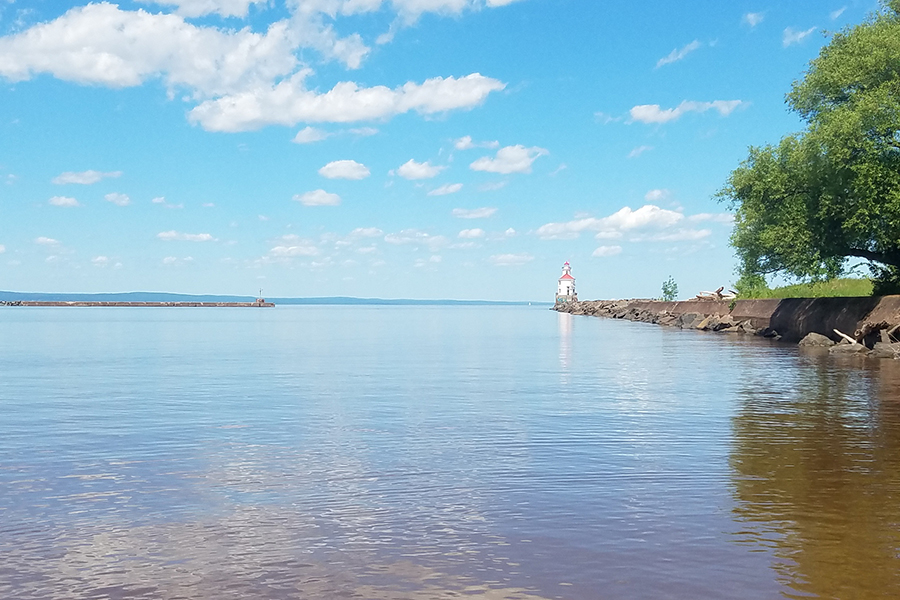TYPE
TOPIC
As warmer summer temperatures approach, Lake Superior researchers urge the public to be on the lookout for harmful algal blooms, also known as HABs, blue-green algae, and cyanobacterial blooms. HABs often grow in inland lakes with abundant nutrients and warm water, but they have also been seen on the shores of Lake Superior in recent years.
The Lake Superior National Estuarine Research Reserve is one of 30 Reserves around the country tasked with protecting and studying estuaries and coasts. Research at the Lake Superior NERR focuses on the St. Louis River Estuary and coastal Lake Superior, where HABs have been observed in recent years. Lake Superior NERR researchers are currently working to understand why blooms appear in Lake Superior, where development in the watershed is relatively low and water temperatures are often cooler than other areas in the Great Lakes.
What are HABs?
Cyanobacteria, also known as blue-green algae, can grow into accumulations called harmful algal blooms. Cyanobacteria have the potential to make toxins and can degrade environmental health when they grow in high numbers. HABs pose a threat to the environment because they can block sunlight and use up oxygen needed by other plants and animals. Blooms can also create undesirable recreation conditions including unsightly scums, foul odors, and health risks.
Reports of blooms in Lake Superior began in 2012. Since 2012, blooms have been reported in most years. The majority of the blooms have been small, isolated events. In 2018, a widespread bloom led to many individual observations. Current data indicate that bloom frequency has increased in recent years, but this may be due to increased awareness.
What are the risks of HABs?
HABs have the potential to make toxins. Common toxins can include skin irritants, liver toxins, and neurotoxins. Toxin exposure is most commonly from swallowing water when a toxic bloom is present but inhalation of blooms and their toxins may occur in some cases, such as when using motorboats and water is spraying into the air.
To date, two blooms have had detectable levels of toxins: one at Barker’s Island beach in the St. Louis River Estuary in 2021 and another at Wisconsin Point Beach in Lake Superior in 2022. The 2021 bloom had microcystin (a liver toxin) of 8 µg/L, the EPA limit for recreation. In the 2022 bloom microcystin was detected at lower levels, approximately 4.8 µg/L. Most reported blooms in Lake Superior have not been toxic.
What does a bloom look like?
The appearance of HABs can be variable, but some clues to look for are scums that look like spilled latex paint, lots of small green or brownish dots in the water, green “pea soup” discolored or streaky water, floating scum that breaks into tiny particles, or dead fish or other dead animals in the water. Check out the infographic below for pictures that can help determine if a HAB is present.
How can I protect myself and my family?
A good rule of thumb is: When is doubt, stay out. If you see green water or scums on the beach, it’s probably a good idea to stay out of the water and pick a location with clearer water for swimming. Kids and pets are most often affected by HAB-related illnesses, since young kids may tend to drink water while swimming, and dogs won’t hesitate to drink green water.
Who do I contact if I see a bloom?
It is important to notify the right agency if you see a bloom so that samples can be collected and analyzed for toxins. This information can also be used by researchers to understand what causes HABs. The public can use the following contacts to report a bloom in inland waters or Lake Superior.
- MN Waters: algae.mpca@state.mn.us or call 651-757-2822 or 800-657-3864
- WI Waters: dnrhabs@wisconsin.gov
- MI Waters: AlgaeBloom@michigan.gov
- Ontario Waters: call the Spill Action Center at 1-866-MOE-TIPS (663-8477)
